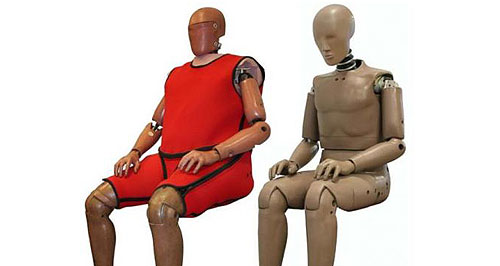Make / Model Search
News - General News - SafetyHumanetics says obese dummy will save livesCurvy model: Humanetics' latest prototype simulates a person with a body mass index of 35 and the company says it will improve vehicle design and crash safety for obese people. Leading crash test kit-maker says skinny dummies don't match ballooning population5 Nov 2014 THE world's leading manufacturer of crash test dummies is developing an obese model that more accurately mimics a globally increasing population of overweight drivers. With more than 130 channels of information, modern dummy designs offer advanced analysis of crash conditions and the effects on occupants, but the basic weight and dimensions of the equipment have changed little in recent years. American manufacturer Humanetics' 124kg prototype dummy behaves like an obese person at the wheel allowing more precise modeling of crash conditions for overweight occupants who, it says, are at much higher risk of death and serious injury than healthy people. Humanetics told CNN that obese people are 78 per cent more likely to die in a collision compared to normal weight passengers and the new obese dummies allow a better understanding of what happens to an overweight person when subjected to extreme forces. During the rapid deceleration of a crash, body weight is proportionally multiplied many times: The greater the initial mass, the greater the forces a human body places on safety restraint systems. Depending on the circumstances, when subjected to a high speed impact of approximately 100km/h, the 80kg mass of an average male can multiply to about 1200kg, but an obese body mass of 130kg causes the relative impact mass to soar to nearly 2000kg on impact. The additional forces of a larger body require greater strength of restraint systems such as seats, seatbelts and airbags if they are to perform comparably to lower mass occupants. But the additional strain of larger masses can be compounded by the different shape of an overweight individual with forces concentrated around the middle of the body rather than the more even spread of a healthier occupant. Tests of the prototype will allow more accurate computational modeling by manufacturers resulting in more trustworthy virtual tests and functions such as the addition of subcutaneous fat to simulate even larger people. The dummies currently in use represent a healthy and 'average' human but statistics show the definition of average has shifted since the introduction of the dummies. With more than five million obese people, Australia sits in fifth place in the obesity world rankings, but that figure is climbing faster than anywhere else globally. Elderly bodies also behave differently to young healthy bodies during a crash and Humanetics is also working on an 'old' dummy which will be ready in prototype form next year. With new body-type specific information available, car manufacturers will be able to reset the definition of the average human dimensions leading to safer vehicles, says Humanetics. Another approach might be to offer a more tailored driver's seat in much the same way a motorcyclist selects the correct size crash helmet. Australian New Car Assessment Program (ANCAP) chairman Lauchlan McIntosh told GoAuto that while the technology has potential, the organisation will be waiting for compelling results before committing to the use of a supersized crash-test dummy. “I think there are a lot of other important things too and it's a question of the priority,” he said. “The dummies are very expensive and we use a very standardised process at the moment and it's standardised worldwide. “To move away from that would require quite a lot of research and I think we would need to see the results first to see how important it is and what the differences are.” Mr McIntosh explained that car-makers already build vehicles to accommodate a wide range of driver parameters and that any benefit of an obese dummy might not be as great as other areas of research. “It may well be that manufacturers are making vehicles that are adequate for people of different sizes anyway. “We need to tread carefully when looking at these other options and there could be other things we should be studying instead that could be just as important. “It's an issue, but it's one we need to watch carefully. “There are some far more important issues at the moment and trying to improve the crash avoidance and crash worthiness as equals.”  Read more |
Click to shareGeneral News articlesResearch General News Motor industry news |












Facebook Twitter Instagram